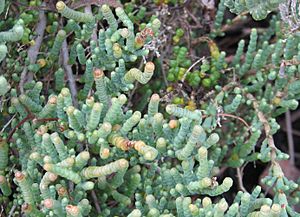Blackseed samphire facts for kids
Quick facts for kids Blackseed samphire |
|
|---|---|
 |
|
| Tecticornia pergranulata subsp. pergranulata | |
| Scientific classification | |
| Genus: |
Tecticornia
|
| Species: |
pergranulata
|
| Subspecies | |
|
|
| Synonyms | |
|
|
The Tecticornia pergranulata plant is also known as the blackseed glasswort or blackseed samphire. It is a special type of plant that stores water in its parts, like a cactus. This plant loves salty places. It is found naturally in Australia.
Scientists often study this plant in labs. They want to learn about its unique way of making food from sunlight (called C3 photosynthesis). They also study how it can survive in very salty conditions and tough environments.
Contents
About Blackseed Samphire
Tecticornia pergranulata is a small plant that looks like a tiny bush. It has stems that can bend and are full of water. These plants usually grow to about 1 meter (3 feet) tall.
Their branches are a bit swollen and have small leaf-like parts. You can mostly find them near salt lakes and salty swamps. These areas are all over southern Australia. The plant is famous for being able to live in very salty places and even when there are floods.
How It Survives Floods
This plant has an amazing way to survive when its home gets flooded. Researchers like Sarah M Rich, Martha Ludwig, and Timothy Colmer studied this. They found that Tecticornia pergranulata can do something special. Its roots can make food from sunlight, just like leaves do. This helps the plant live through big floods.
Bigger Tecticornia pergranulata plants grow many extra roots. These roots grow from the woody part of their lower stem. Smaller plants do not grow these water roots. But they do grow extra roots in the soil. The water roots on bigger plants come in two different types. They look different in color and length.
Different Kinds of Roots
One type of root grows only in the water. These roots float in the water and are very thin, less than a millimeter wide. They are usually pink on the outside. Sometimes, they can be brownish-green, especially near the bottom of the plant. These are called aquatic roots.
The second type of root is greenish-brown on the outside. These roots are thicker than the aquatic roots, about 1 to 3 millimeters wide. They grow down through the water and into the soil below. These are called semi-aquatic roots.
How Roots Help the Plant Breathe
The roots of Tecticornia pergranulata can make oxygen through photosynthesis. This oxygen can then go to the rest of the plant. This is super helpful when the plant is underwater during a flood.
The cells inside the aquatic and semi-aquatic roots have tiny parts called chloroplasts. These chloroplasts are like tiny factories. They make oxygen when there is light and carbon dioxide in the water. They also have special proteins that help them make oxygen and turn carbon dioxide into food.
Unlike the roots that stay in the soil, the water roots can get oxygen from the water. They can also make their own oxygen inside. So, when both the semi-aquatic and aquatic roots are underwater, they do photosynthesis. This gives the plant the oxygen it needs to survive.
Other Uses of Glassworts
Tecticornia pergranulata belongs to a group of plants called Glassworts. In the past, people would burn these plants. The ash from glassworts was used to make "soda ash." Soda ash was a very important ingredient. It was used to make both glass and soap.
Types of Tecticornia
Here are some types of Tecticornia plants:
- subspecies elongata
- subspecies divaricata
- subspecies pergranulata

